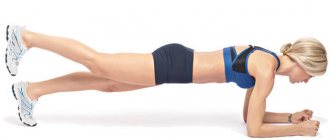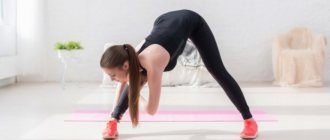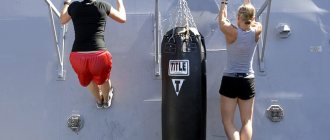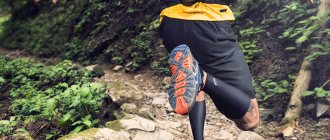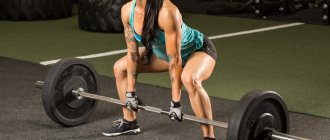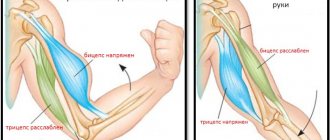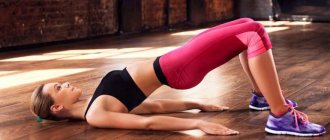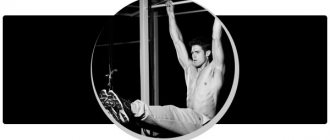Dynamic bar
This is one of the many versions of the bar, but in dynamics. This exercise can work almost your entire core in a short period of time—according to Richard Wilcock, the dynamic plank works 6 different core muscle groups.
Technique:
- Stand in a regular elbow plank position with your forearms on a ball (preferably an exercise ball).
- Keeping your core engaged and your body still, begin rolling the ball in a small clockwise circle using your hands. 1 round – 1 rep.
Do the required number of repetitions.
"Bird Dog"
This exercise comes from yoga. It involves almost the entire body and is aimed at finding balance. According to certified trainer and Aaptiv (fitness app) head instructor Jaime McPhaden, bird dog is a healthy, low-impact exercise that helps improve stability and coordination without putting too much pressure on your joints.
Technique:
- Get on all fours, knees at a 90-degree angle, hands under your shoulders. Remember to keep your abs tense and your back straight.
- Extend your right arm straight out in front of you and at the same time move your left leg back.
- Complete the movement by connecting your right elbow with your left knee under your body. Return to the starting position and repeat the same with your left arm and right leg.
Do the required number of repetitions.
see also
17 real weight loss tips from people who have lost more than 20 kg
Gluteal bridge
“Weak core muscles are often associated with weak gluteal muscles,” noted trainer Jaime, already familiar to us. According to the expert, this is an ideal exercise that you can do not only in the gym but also at home to strengthen your hamstrings and buttocks.
Technique:
- On the mat, lie on your back with your knees bent and your feet flat on the floor. Keep your heels directly under your knees. Place your arms at the sides of your body, palms down.
- Push off with your heels, straining your buttocks and abdominal muscles, lift your pelvis as high as possible.
- Hold at the maximum point for a few seconds, making sure that your spine does not round and your pelvis does not sag.
- Return to the starting position.
Do the required number of repetitions.
Formative muscles and functions
The word “core” came into Russian from English (core), and is translated as center, core. It transfers force between the upper and lower body. The core is not only the abs, but also the area around the spine, in the groin. This group includes the following muscles:
- abdomen - oblique, transverse, straight;
- buttocks - small and medium;
- back of the thigh;
- infraspinatus;
- coracobrachial;
- leading.
The condition of these muscles depends on:
- presence and size of the abdomen;
- posture;
- chest shape;
- spine and hip health;
- the functioning of various body systems - genitourinary, especially in women, digestive, excretory;
- strength - body, explosive;
- ability to maintain balance;
- movement speed;
- correct position of internal organs.
"Cot"
The “clamshell” will help strengthen the muscles of the hips and pelvic floor even for those who are still new to the world of fitness. The exercise evenly distributes the load between the muscles of the inner and outer thighs.
Technique:
- Lie on your side with one leg crossed over the other. Bend your knees at an angle of 45 degrees.
- Place your head on your forearm.
- Pull your stomach in, as if pulling your navel towards your spine.
- Keeping your feet touching, lift the knee of your top leg as high as possible. Try to make the movement only with your knee, without rotating your pelvis. Your bottom leg should not leave the floor.
- At the top, pause for one count, then return your leg to the starting position.
Repeat.
Exercises for the core muscles[edit | edit code]
“Methodological planning of a training program”
Scientific manual ed.
Professor L.P. Lysova, 2016 Main article: Training the core muscles (supporting muscles)
Each movement begins in the central part of the body. That is why the correct position of the torso and pelvis is a necessary condition for performing any movement. The absence or lack of stability of these body parts prevents the effective use of leg or arm strength. Therefore, the stability of the trunk and pelvis is an essential factor that has a significant influence on movement.
In the absence of a stable muscle corset in the area of the shoulder girdle, abdomen/back and hips, it is impossible to maintain the correct position of the torso. In this case, the movements of the arms and legs are blocked, since pendulum-like movements of the limbs can only be effectively performed if there is a strong support.
Remember
: Stability of the trunk and pelvis is a necessary condition for performing movements. It represents the basis of strength training in all sports disciplines.
Particular attention should be paid to the development of the following muscle groups:
- rectus and oblique abdominal muscles (m. rectus abdominis and mm. obliquus internus et externus);
- back muscles (i.e. erector spinae);
- muscles of the interscapular region (m. trapezius and mm. rhomboidei);
- gluteal muscles (m. gluteus maximus);
- abductor muscles of the legs (mm. abductores).
Targeted strengthening of the above muscles is carried out in combination with stretching the hip flexor muscles (m. iliopsoas), hip abductors (mm. adductores) and pectoral muscles (m. pectoralis major). Basic exercises for the development of these muscle groups can be performed anywhere and do not require any auxiliary equipment. We call them, depending on their intended purpose, athletics, sprinting, running, throwing, general physical or even football turns. The principle is extremely simple: the trainee makes one complete rotation around the longitudinal axis of the body and after each 90° rotation performs the appropriate exercise to develop strength.
Athletics turns[edit | edit code]
For optimal results, this exercise should be performed daily, beginning with the specialized training phase and independently of the training itself. You can increase the intensity of this exercise by performing not one, but two to five rotations (with a total of eight exercises) around the longitudinal axis of the body. Later, you can increase the load when introducing new exercise variations, using the Physioball and appropriate equipment for strength training.
1. Straight body lift to strengthen the rectus abdominis muscles
Initial position
- lying on your back, legs bent with emphasis on your heels, toes pulled towards you.
The lower back is pressed tightly to the floor. Stretch your arms parallel to your body forward towards your legs. Pull your stomach in and then lift your head first and then your torso, gradually increasing the amplitude of this movement until your shoulders are lifted off the floor. Next, either raise and lower your torso with short, small movements, or hold your torso in a raised position for some time (for example, 30 s). It is important to continue breathing slowly and calmly. Attention: it is strictly forbidden to fix your legs.
2. Lying on your side to strengthen the lateral abdominal muscles
Initial position
- lying on your side with emphasis on your forearm, your free hand rests on the side of your body. Both legs are straightened, toes are pulled towards you. Tighten your stomach and buttocks and lift your torso until your shoulder, hip and knee form a straight line. Hold this position for 30 seconds, then slowly return to the starting position. Stop the exercise when the pelvis falls forward.
3. Balance on one leg to strengthen the back extensors
In a position on all fours, horizontally raise your opposite leg and arm so that they are in a position parallel to the body, pull in your stomach and hold this position for 30 seconds. Then change arms and legs and repeat the exercise. Make sure that the pelvis does not fall to the side (both buttocks should be at the same height).
4. Side lying to strengthen the lateral abdominal muscles
This exercise is performed in the same way as exercise 2, but lying on the other side.
5. Bridge to strengthen the gluteal muscles
Initial position
- lying on your back, legs resting on the floor, arms parallel to the body, palms pressed tightly to the floor. Tighten your stomach and buttocks and lift your buttocks until your torso and thighs form a straight line. Hold this position for 30 seconds, then slowly return to the starting position. Attention: the cervical spine should be pressed firmly to the floor.
6. Leg abduction to strengthen the abductor muscles
Initial position
- lying on your side, lower leg bent at the hip, knee and ankle joints by 90°. The head rests on the lower arm, the upper arm lies in front of the body and supports it. Tighten your stomach and buttocks and lift your top leg, pulling your toes toward you. Next, either raise and lower your leg with short, small movements (it should not touch the lower leg), or hold your leg (for example, 30 s) in this position. When performing this exercise, the upper leg should not go forward.
7. Raising your arms to strengthen the muscles of the interscapular area
Initial position
- lying on your stomach, feet resting on the floor with your fingertips, hands lying on the floor, forming 90° with the line of the body. Raise your arms and lower them with short movements (with your hands not touching the floor) or hold them (for example, 30 s) in a raised position.
8. Leg extensions to strengthen the abductor muscles
This exercise is performed in the same way as exercise 6, but lying on the other side.
Pallof press
Side pulley forward press. This is a core strengthening exercise that also forces the body to minimize stress on the back during various body movements, such as squats or running.
Technique (in the gym):
- Attach a standard overhead pulley D-handle and position it at shoulder height. You can also use the bottom block.
- Standing with the left side of your body at the machine, grab the handle with both hands and move away from the block a few steps to feel the tension on the cable.
- Place your feet shoulder-width apart and bend your knees slightly. Hold the handle at mid-chest level - this will be the starting position.
- As you exhale, pull the cable with straight arms. The core muscles should be tense and engaged. Hold for 2 seconds before returning to the starting position.
Do 10 reps on each side.
What are the core muscles for?
The core muscles are responsible for:
- posture;
- equilibrium;
- beautiful abs and buttocks;
- flexibility, body strength;
- health of the excretory, circulatory, digestive, genitourinary (especially female) systems;
- spinal health (especially important for sports fans to avoid overload and injury);
- coordinated work of the remaining muscles of the human body.
Strengthening your core muscles
To strengthen your core muscles you need:
- Watch your posture; it is especially important to keep your back up for those who have a “sedentary” job.
- Relax actively - ride a bike, swim, walk.
- Develop a training program and schedule. Be sure to pay attention to the entire core musculature, without getting carried away with pumping just one muscle. Otherwise, it will shorten and cause an imbalance in the core, and, consequently, in the entire body.
- Be sure to contact your doctor, listen carefully to your feelings during and after training, and adjust your individual program in accordance with the recommendations of a specialist and your own well-being.
- Combine training with massages, physiotherapy procedures, and follow all medications prescribed by the doctor.
- Fall in love with stretching - a special set of exercises for stretching muscles and ligaments.
- Tighten your abdominal and buttock muscles throughout the day.
Features of strengthening the core muscles of women
- The right shoes. No matter how much the fair sex loves their image of a “fatal beauty,” when thinking about their health, high stiletto heels should be abandoned. This unchanging attribute of femininity is allowed only occasionally for “going out.” At the same time, there is no need to go to extremes and change into sneakers. A small 5 cm heel for women is useful. So, the stomach automatically retracts, the shoulders straighten, and the buttocks tuck.
- Purposeful tension of the abdominal and thigh muscles during the day (not at all necessary in the gym, this can be done in the office if you have a free minute) is more effective for women than for men. Thus, tension of the abdominal muscles (of course, not just once) invariably leads to getting rid of loose fat deposits, which in women are located on the surface. Men's fat deposits are denser, located deep, and can only be corrected by active physical activity and nutrition. Tension of the muscles of the female buttocks has a pleasant bonus in the form of training the muscles of the perineum, which will definitely be noted by the partner during intimacy and will prepare the body for pregnancy and childbirth.
- To avoid complications, it is not recommended to strengthen the core muscles for women during treatment of any gynecological diseases, as well as pregnancy.
"Dead Bug"
The Dead Bug is a static exercise that targets the abdominal, back and thigh muscles. Doing it regularly will make it much easier to do other exercises that involve moving your legs and arms while keeping your abdominal and back muscles stationary but engaged.
Technique:
- Lie on the floor, bend your knees and lift them so that a right angle forms between your knees and hips.
- Extend your arms towards the ceiling.
- Reach your left leg with your right hand. Try not to lift your lower back off the floor.
- Pause and return to the starting position.
- Repeat with the other arm and leg.
Do the required number of repetitions.
see also
The Real Reasons Why Muscles Get Tired During Exercise
The Best Exercises to Train Your Core Muscles at Home
Plank
A static exercise that involves all the muscles of the center at the same time.
- Place your hands under your shoulders, your feet the width of your pelvic bones.
- Tighten your stomach, tighten your buttocks, squeeze your shoulder blades together.
- Pull the top of your head forward.
- Hold the position without holding your breath.
Learn more about the plank exercise →
Exercise "swimming"
Strengthening the core of the body, stretching and strengthening the back, arms and legs.
- Starting position on all fours: hands under the shoulders, knees under the pelvis.
- At the same time, extend your arm and the opposite leg, straightening it until it is parallel to the floor as you inhale.
- Exhale, lower your arm and knee and switch sides.
- Keep your stomach tense, avoiding arching in the lumbar region.
Concentrate on lengthening your muscles.
Twist up/down
The transverse abdominal muscle is strengthened and the hamstrings are stretched.
- Sitting on your buttocks, bend your knees, place your heels on the floor, and keep your hands in front of you.
- Having stretched the top of your head, inhale, then as you exhale, slowly lower yourself onto your back, vertebra by vertebrae, starting from the tailbone.
- At the bottom, take a breath and just as slowly lift your neck, and so on, each section one by one, without jerking or using your hands.
Fully straighten your spine at the top.
Shoulder bridge
The shoulder bridge exercise develops the muscles of the thighs and buttocks.
- Lie on your back, place your heels under your knees, the width of your pelvic bones.
- Inhale, and as you exhale, lift your buttocks, as if you were twisting your pelvis, tearing off vertebrae by vertebrae, but do not collapse your chest towards your neck.
- Inhale at the top, and just as slowly lay your back on the floor.
Oblique crunches
Strengthens the core muscles, mainly the obliques and rectus abdominis, shaping the waistline.
- Lie on the floor, keeping your shins parallel to the floor.
- Place your hands behind your head.
- Lift your shoulder blades off the floor and hold the position until the end of the approach.
- Inhale, and as you exhale, twist your body to the side: elbow to the opposite knee.
- As you inhale, return to the center and repeat the twist in the opposite direction.
"A hundred"
“The Hundred” is a fairly simple but effective exercise that comes from Pilates. It is aimed at stabilizing the lumbar spine and strengthening the abdominal muscles. Daniela Caesar-Roden, a certified Pilates instructor at Old School Pilates, notes that it's important to pay attention to breathing, as the exercise also affects the diaphragm, which stabilizes the core muscles, especially during deep exhalations.
Technique:
- Lie on your back, place your arms along your torso, raise your legs and bend them at a right angle.
- Exhale and use your abdominal muscles to lift your upper body off the floor. Press your lower back to the floor by tensing your abdominal muscles and drawing in your abdomen.
- Raise your arms parallel to the floor and hold.
- Keeping your legs at right angles (or, if you want to complicate the exercise, at an angle of 45 degrees), begin to make up and down patting movements with tense hands, without bending your elbows or touching the floor. Do 5 beats on a long inhale and 5 beats on a long exhale. Remember to keep your core tense. You have completed 1 cycle. Over time, try to do up to 10 cycles.
What is core? What is core training?
Core
(Core) – the biomechanical zone of the center of gravity (also referred to as the body or torso). The core muscles are deep muscles that lie next to the spine and provide its fixation. Core training – training the core of the body and building a strong foundation around the spine.
Initially, core training was associated with exercises for the transverse abdominal muscle. This muscle is the deepest muscle layer of the abdominal wall. It is designed to hold the internal organs in place, gives the waist a slim appearance and is responsible for stabilizing the lumbar region.
The purpose of such training is to develop muscle endurance - that is, long-term exercise with additional load.
Elbow plank
The classic plank is one of those exercises that involves and puts a lot of stress on the main muscles of our body. At first glance, the exercise may seem simple - but just try it!
Technique:
- Take a lying position, leaning on your forearms.
- Place your hands shoulder-width apart.
- Keep your body above the floor without lifting your pelvis up. The abs should be tense, the shoulders should be relaxed, and the back should remain straight. Your body should form a stationary line.
- Hold the position for as long as you can. Start with 20-30 seconds, gradually increasing the time to 1 minute.
see also
How to pump up your abdominal muscles with one forgotten wiper exercise
Some training tips
- Prioritize exercises that require core stabilization, movement on unstable surfaces, and resistance-building strength exercises.
- Do weight-bearing , as every muscle in your core works hard during heavy activity to stabilize your spine and torso.
- Combine movements of the upper and lower extremities to facilitate torque transmission. Choose from a variety of exercises, from classic yoga poses to push-ups. It will all depend on how intense you want the exercise to be.
- Include static and dynamic exercises in your program so that all muscle groups work during exercise.
- Every workout plan should have at least 4 core exercises.
- Try to do 3-5 sets of each exercise.
- Perform 10 to 20 repetitions of dynamic exercises. Once you can successfully perform three to five sets of 20 reps, add weights.
- It is better to start performing isometric exercises with a 1:1 , 20 seconds each period, gradually increasing the time by 10 seconds to 60 seconds.
Side plank
The side plank is another effective exercise that strengthens the abdominal muscles without putting stress on the spine.
Technique:
- Lie on your left side. Lean on your left elbow, placing it directly under your left shoulder. Place your right foot on top of your left.
- Raise your hips up, transferring your body weight to the tips of your legs and forearms. The main load should fall on the core muscles.
- Pull your stomach in and tighten your abs.
- Stay in this position, focusing on your breathing.
What are the core muscles, where are they located and what are they responsible for?
Today it is fashionable to do fitness. Probably, reader, you also visit a fitness club, which means you have heard about core muscles. This article will help you find out what the core muscles are and understand what methods are more effective to use to strengthen them.
A good example is the sculpture of a man throwing a shot (you've probably seen it in parks and museums). A man holds a cannonball in one hand, preparing to throw. Shifting his center of gravity to his body, he leaned forward. The moment - the cannonball will fly to the target.
We will not bore the reader with discussions about which muscle fibers make up this group; we’d rather try to answer the question asked.
Read more: Alkaline diet food list menu reviews
Experts say that amateurs, professional athletes, and just exercise enthusiasts train different types of muscles, but the main emphasis is on training related to their own body weight.
Trained core muscles, like those of an athlete, make it easier to perform any physical exercise. Such athletes, as a rule, reach the finish line without injury. It is interesting that in interviews the winners do not hide the secrets of success: constant training of the spine, that is, the core muscles, in other words, developing the ability to send a signal - “core” - to the muscle fibers associated with movement.
It is necessary for any inhabitant of the planet to accustom this group to ever-increasing physical activity, because it is extremely important in human activity. Bypassing anatomical terms, we can explain the functions to the reader:
- Muscle threads are connected to the spine and abdominals. Being in a balanced state, they allow a person to bend in different directions and make various movements.
- It’s not for nothing that mothers, when forming correct posture in their daughters, advise them to look at the tops of the trees. At such a moment, the spinal muscles tense and get used to maintaining a certain position.
- Any young girl dreams of having perfect thighs: training the muscles in this part of the body contributes to this. Guys strive to have strong biceps, which is why they choose exercise machines.
- A person with trained muscles of this group has an athletic build; a trained abdominal press allows you to easily pull your knees to your chest.
- Core muscle training – creating support for internal organs.
How to train?
Dear readers, having gleaned a little information, are eager to get an answer to the question: “How should this type of muscle be trained? What physical exercises can you choose for this?”
Training needs to be done constantly. The girl who goes to the fitness club once a week is deeply mistaken. Remember, young girls, that beautiful posture and muscle fitness can only be acquired through constant exercise. Therefore, take this advice: morning exercise and home exercises.
By the way, don’t forget to spend five to ten minutes at work to give your body a workout. Don't make a surprised face! You don't have to do exercises on a mat in the office area. But simple rhythmic movements can be performed unnoticed by others:
- If you need to get a folder with papers on the bottom shelf, sit down and stand up several times, holding the taken papers in your hands.
- Or, conversely, stretch your stomach when reaching for something in the top closet. Do this several times.
- When going to another department, straighten your shoulders, feel your abdominal muscles - and walk like a queen.
Exercises at home
After returning home, having prepared dinner, spend about twenty minutes exercising. Here, do not spare your body, give it such a load to feel tired:
- A classic exercise can be the “bridge.” To do this, lie on your back and bend over like a cat. Do not forget to fix the position of the body for several minutes in the upper position. Try placing your hands on the floor first, and then complicate the task by clasping your hands behind your head. If you decide that your butt muscles are tired, give yourself a two-minute break and move on to other exercises.
- Roll over onto your stomach and, leaning on your elbows and feet, tense up. Keeping your back straight, tighten your abdominal muscles. In this position, indulge in pleasant thoughts.
- Now try to make it more difficult: turn to your side, rest on your hand, bent at the elbow. Straighten up. Hold the position as long as you can. Turn to the other side. If, after performing these simple exercises, you have a charge of vivacity, then it means that you can continue exercising.
- The “bridge” exercise is known to everyone from school physical education lessons. Now we just need to complicate it. Take the starting position, raise one leg, straighten it and for several minutes monitor the straightness of the line of the leg and body.
- Make the activity more difficult by leaning on your elbows bent at right angles. Try to lift your leg without bending it at the knee and move it to the side. Repeat the exercise by doing the same with the other leg.
The third period of training begins after the body gets used to the load. Now you can perform all exercises with dumbbells in your hands. Are you carried away? The husband says that dinner is cold. Ten minutes for a refreshing shower - and the conversation began at the evening table. Invite your loved one to go on a bike ride or visit the pool this coming Sunday.
It's time to say goodbye to readers. Did you like the notes about the core muscles and what they are? Then stay tuned for new tips that will appear on the blog pages soon. And if you liked the exercises, then tell the boys and girls you know about them on social networks. When leaving our site, do not forget to leave a review.
Read more: How many carbohydrates does a girl need for muscle growth The whole truth
Spiderman push-ups
This is a fairly complex strength exercise aimed at strengthening the pectoral muscles, triceps, deltoids and abdominal muscles.
Technique:
- Stand up straight with your arms outstretched. Place your hands shoulder-width apart. Tighten your abdominal muscles.
- As you lower yourself to a push-up position, draw your left knee toward your elbow.
- Pause, push up, then return to the starting position. Do the same with the other leg to complete one repetition.
Do the required number of repetitions.
Leg raises while lying on your back
Many trainers recommend this exercise to strengthen the abdominal muscles, especially in the lower part, because it is quite simple, but at the same time effective. Plus, it can be done anywhere.
Technique:
- Lie on your back with your legs raised towards the ceiling. The arms are extended along the body or clasped behind the head.
- While pressing your back, slowly lower both legs down without touching the floor.
- Slowly lift them back up.
Repeat.
Beginner's Guide: How to Build Your Core Muscles
Each person sees core training differently. Some spend their classes doing an endless number of crunches, don’t get tired of pumping up their abs endlessly, others spend countless minutes doing planks. The fact is that these exercises alone are not very effective, and neither one nor the other will lead to the desired result. Core training needs to be approached holistically.
Core muscles are needed to create, control and prevent movement. While some muscles, namely the deep stabilizers, respond well to isometric exercises (planks, for example), muscles that create movement (for example, obliques and rectus) respond well to dynamic movements. Therefore, both men and women need to add a wide variety of movements to their training program to achieve maximum results.
Mahi "Woodchop"
An exercise similar to the lumberjack movement engages the core muscles, causing them to resist side-to-side movement. The exercise is aimed at strengthening the abdominal muscles, especially the obliques.
Technique:
- Take a standing position. Feet slightly wider than shoulder width.
- Hold the dumbbell with both hands and lift it above your head, rotating your shoulders up to the right.
- Exhale and lower the dumbbell down diagonally across your body, ending behind your left hip.
- Return the dumbbell to the starting position.
Do the required number of repetitions.
How to strengthen your core muscles: 4 effective types of planks
The core muscles are a whole complex of muscles responsible for stabilizing the core. Strong core muscles are the basis of health and at the same time the most vulnerable spot of any athlete. Core training is the fastest and most effective way to get in shape.
There are two popular ideas about basic training. On the one hand, there are functional exercises. You know the ones: “belly breathing” or training your pelvic and gluteal muscles all day.
And there is another form of training that proclaims: “I don’t need to directly train my core, I just do squats and deadlifts.”
The truth lies somewhere in the middle.
Core muscle training accomplishes two main tasks:
- They prevent unnecessary movement. The core muscles protect the internal organs, like the spine, from folding like an accordion, and set you up for active training.
- They strengthen both the upper and lower body. Think about how to minimize possible unnecessary energy expenditure in the spine. During squats, your core muscles will help you maintain static, neutral position, which will make the workout much more enjoyable.
Back injuries can be a death sentence when training hard. And injuries tend to happen either due to poor technique or lack of core muscle activation. Core muscle activation, however, is something you can control.
Most gym athletes do typical office work and sit in the same position for 8-12 hours a day, 300 days a year. This makes sudden exercises in a bent position (deadlifts, squats) risky. By starting to train your lower back, you activate dormant muscles that spend most of the day relaxed.
If the muscles primarily responsible for preventing unwanted movement are not activated, how can you expect them to keep your spine from collapsing as soon as you add heavy weights to the barbell? You can not. The muscles are not activated and cannot support massive weight and improve your form. Let's change that.
Activate your core muscles. Take a balanced approach and activate all the functions of this area. This means training in several areas: static stabilization, dynamic stabilization and integrated stabilization.
Do static exercises. Maintain balance and a straight back. Workout options: plank exercise, stretching, general resistance exercises, general training, exercise ball stretching and dumbbell wheel exercise.
Stretch your side muscles. Make sure that your body does not bend under the weight of the dumbbells when you hold them in both hands.
Resistance to lateral flexion is provided primarily by the quadratus lumborum and oblique abdominal muscles. Workout options: side plank exercise, farmer's walk exercise, deadlift exercise.
You can simply carry your purchases from the store in both hands. In general, all those exercises where you, despite the load, maintain balance.
Do anti-rotation exercises. True anti-rotation exercises aim to prevent resistance to rotation in the lumbar spine. You may see someone with a wooden dowel or barbell on their shoulders, rotating from side to side. If you are worried about disc herniations and are afraid of getting a hump, please don't do this.
Yes, some athletes require rotational loads, but they are based on strength and rotation prevention and stability first and foremost. Workout options: press exercise, one-knee stand exercise, weight-bearing kneestand exercise.
Read more: Plie squats technique, what muscles work
Attention!
Compound exercises such as dumbbell power cleans or renegade rows are also good.
Work on the gluteus maximus muscle. Maintain a neutral, stable spine during strength exercises: move like an accordion during squats or deadlifts.
The role of the gluteus maximus muscle is to stretch the hip (reduce load, push off in sprints), move, externally rotate (rotate the leg) and internally rotate (rotate the leg). Training options: pendulum hip extension from a standing position on all fours, clamshell exercise, exercise with an expander.
Additionally, multi-joint exercises such as squats, glute bridges, rows and lunges with an emphasis on full hip extension and expansion of the gluteus maximus muscle in the movement.
Many trainers and researchers argue that the gluteal muscles should become a mandatory element of physical activity, but without losing the neutral position of the spine.
In cases like these, the quad position teaches athletes to tighten their abdominal muscles and expand their gluteus maximus.
Extrapolating this function and applying it to larger squat loads is what we want to achieve.
Make a plan
Stimulate, don't destroy, your core muscles. This is best done during or after a dynamic warm-up before your first weight load. Remember that body position is the main focus, so don't try to be overly active and chase fatigue. Choose which level of training best suits your needs.
Do gluteus maximus activation and anti-lateral flexion exercises.
Exercise “Plank” 2-3 sets of 45-60 seconds. Hip flexor stretch 2 sets 8 reps each side
Side plank exercise 2-3 sets of 45-60 seconds
Plank
Kristina Podrezova
Take a lying position, extend your arms under your shoulders (the body should form a straight line from the shoulder girdle to the legs).
The legs should be straight, without bending at the knees, the pelvis should be twisted (not tending upward), the abdominal muscles should be tense and, if possible, pulled towards the ribs.
The lumbar region should be flat, and the legs should be placed together to increase the load on the abdominal muscles. Lock in this position for 40 seconds.
Plank with rolls
Rotate your hips first in one direction, then in the other. When turning to the side, you can lightly touch the floor with your hips.
Do 20 repetitions (both right and left turns are counted at one time).
Plank with arm raise
Take a classic plank position with your arms straight. Feet are the width of the mat. The abdominal muscles are tense.
Raise your hands one by one and touch your shoulder.
Do 20 repetitions (one repetition is raising the right and left arms).
Dynamic bar
Assume a regular plank position with your arms straight. The back should not bend. Don't lower your pelvis too low.
Important!
First, bend your right arm and lower yourself onto your elbow. Then bend your left arm. Raise your right and left arms in sequence. Lower yourself to your elbows again.
Do 20 times.
We thank the Boxing Brothers Club for their help in organizing the filming. Related articles Downloading your abs: 5 coolest types of planks What will happen if you do a plank every day 20 ways to do a plank 10 types of planks you had no idea about
